Nikon 1 J3 Review
Nikon 1 J3 Introduction
The Nikon 1 J3 is the mid-level model in the Nikon 1 system of Mirrorless cameras. The system comprises of a new electric lens-mount paired with a 3:2 aspect ratio sensor having a 2.7X crop factor. This makes it possible to shrink Nikon 1 cameras and lenses compared to all but one Mirrorless system.
Nikon developed a new 14 megapixels high-speed CMOS sensor, shared between the J3 and V2. The sensor features built-in Phase-Detect autofocus at 73 points and reads 135 points for Contrast-Detect autofocus, just like the original Nikon 1 sensor.
This high-speed CMOS sensor can shoot continuously at full-resolution up to 60 FPS, when using single-shot AF, or 15 FPS with continuous AF. This is combined with an electronic-shutter which allows shutter-speeds up to 1/16000s.
The Nikon 1 J3 is very compact for a mirrorless camera. Its body measures just 29mm thick, a specification that compares to ultra-compact cameras except that a lens needs to be added to use the J3. While it features full manual controls, its limited number of external controls makes those time-consuming to use.
This detailed digital camera review takes a close look at the Nikon 1 J3's features, ergonomics, usability, image quality, performance and video recording features.
Nikon 1 J3 Major Features
- 14 Megapixels High-Speed CMOS sensor
- 2.7X Crop factor, 3:2 aspect-ratio
- Nikon 1 lens mount
- ISO range from 160 to 6400
- Auto ISO with 800, 3200 or 6400 maximum
- 1/16000One sixteenth thousandth of a second. Electronic shutter only. - 30s Shutter-Speed, plus Bulb mode
- Multi-Segment, Center-Weighed and Spot metering
- PASM exposure modes, with Program-Shift
- Exposure-Compensation: ±3 EV in 1/3 EV steps
- Automatic, 6 presetIncandescent, Fluorescent, Sunlight, Flash, Cloudy, Shade and custom white-balance.
- WB fine-tuning, 2 axis, 13 steps, except for Custom WB
- Customizable sharpness, contrast, brightness, saturation and hue
- Single-Shot, Continuous, Manual and Auto focus-drives
- 73-Point Phase-Detect autofocus system
- 135-Point Contrast-Detect autofocus
- 60 FPS Continuous drive
- 15 FPS Drive with continuous autofocus
- Self-Timer: 2s, 5s or 10s delay
- 3” LCD with 920K Pixels
- 1920x1080 @ 30 FPS 1080p HD video
- 1280x720 @ 60 FPS 720p HD video
- 640x240 @ 400 FPS High-Speed video
- 320x120 @ 1200 FPS High-Speed video
- 1920x1080 @ 60 FPS Motion-Snapshot
- Internal stereo microphone
- JPEG and RAW modes
- Optional Optical Distortion correction
- Optional High-ISO noise reduction
- Optional Long-Exposure noise-reduction
- Optional Adaptive D-Lighting
- Sensor Dust-Reduction
- Single Control-Dial
- Built-In flash
- AF-Assist lamp
- Lithium-ion battery
- SDXC Memory slot
Nikon 1 J3 Suitability - What is it good for?
The Nikon 1 J3 features photographic controls similar to advanced compact digital cameras. Those include full manual controls, including manual focus, custom white-balance and detailed image parameters. This camera can record JPEG images, RAW files or both. This gives precise control over the creative aspect of photography.
The major difference between this model and advanced compacts is that the Nikon 1 J3 is an Interchangeable Lens Camera (ILC). This provides tremendous versatility at the cost of new lenses.
Since the Nikon 1 system is new, current native offerings are limited to a handful of basic lenses. There is an adapter which allows the use of F-mount lenses. Lenses with a built-in focus motor (AF-S for Nikkor ones) are able to autofocus using that adapter.
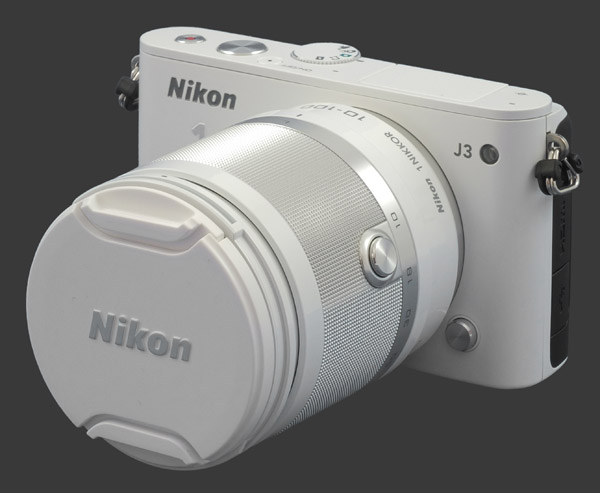
One must consider that the size and weight advantage of a mirrorless like the J3 disappears while using non-native lenses. In contrast, compact cameras have completely retractable lenses with over 10X optical zoom and protruding ones up to 50X.
The Nikon 1 J3 has both an standard mechanical shutter and an electronic shutter. The latter lets the J3 reach shutter-speeds of up to 1/16000s which is faster than any other ILC. It also enables continuous shooting up to 60 FPS at full resolution with focus locked on the first frame or 15 FPS with continuous autofocus. This makes this camera well-suited for action photography. The electronic shutter also makes the J3 ultra-quiet, which is a tremendous advantage under certain circumstances.
Nikon 1 J3 Usability - How easy is it to use?
Nikon took the chance to reinvent things with the introduction of their V1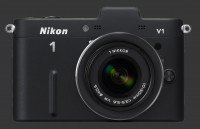
Nikon 1 V1 and J1
Nikon 1 J1 SLDs and now refined things with the J3. Overall, the new interface is reasonably simple and easy to learn but it has its share of oddities.
The Nikon 1 J3 has a rectangular design with slightly rounded sides. There is no hand-grip and the front of the camera is completely smooth, making it highly-recommended to use a strap. Nikon provides a color-matched neck-strap but, given the small size of the J3, a wrist-strap can easily be used instead.
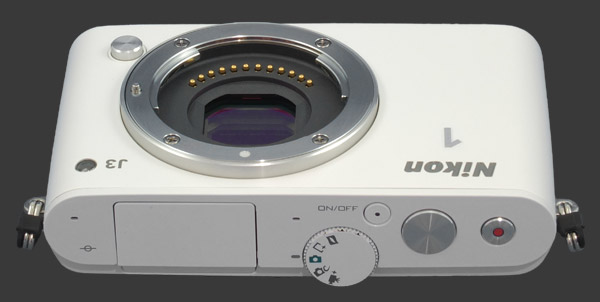
The camera feels very solid except for a flimsy battery and memory card compartment door. Supporting the J3 from the lens, it has a good weight but does not feel heavy at all. Since zooming is done mechanically for the 10-100mm F/4-5.6 VR
Nikkor 1 10-100mm F/4-5.6 VR, this is the natural thing to do. This lens has a collapsible design originally pioneered by Olympus. To expand the lens, press the round button on its barrel and twist. Neatly, this camera automatically turns on when the lens passes the unlocked position.
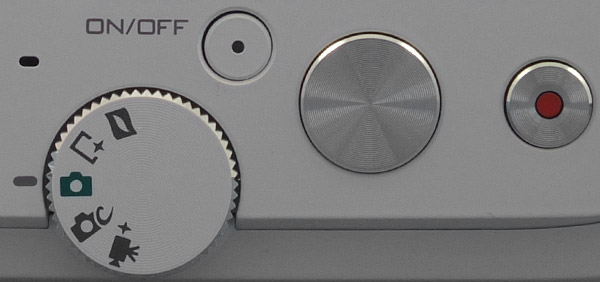
The top of the Nikon 1 J3 has a few simple controls. To the left is an unconventional mode-dial, like the one which appears on the back of the original J1. This one as an extra position for a total of 5:
- Video mode is marked by the silhouette of a classic film camera. This lets the J3 shoot videos in any PASM mode with the obvious limitation that the shutter-speed cannot be set below the frame-rate.
- Creative mode is marked with a camera icon followed by a stylized letter C. This on groups all PASM plus 7 scene modes for stills.
- Auto Image mode is marked by a green camera icon. This automatic mode leaves 4 user-controls available: EC, Motion Control, Background Softening and Active D-Lighting.
- Best Moment gives access to two modes which are unique to Nikon:
- Slow-View: Buffers up to 40 images in 1.3 seconds and plays them back in a loop while the shutter is pressed halfway. When the shutter is fully pressed, it saves the one image shown.
- Smart Photo Selector: Records a burst of images and saves the best one or five, depending on a menu option, according to sharpness and composition.
- Motion Snapshot takes a 16:9 aspect-ratio shot along with a one second slow motion video of the scene which preceded the shot. It also adds one of four sound-tracks while playing the whole thing back. This is a rather gimmicky trick which we would rather see replaced by traditional exposure-modes.
Slight above the mode-dial is a small recessed power button which easily avoids accidental activation. With a collapsible lens, it is redundant as opening and closing the lens powers the camera on and off, respectively.
To its right is a standard two-stage shutter-release with short-travel and a soft halfway point. Further right is a dedicated Video Record button which is almost useless. Pressing it records video in any mode but one cannot see correctly what is being recorded except in Video mode. In Video mode it starts filming but the shutter-button takes stills. The camera could have easily used one button for both functions depending on the mode.
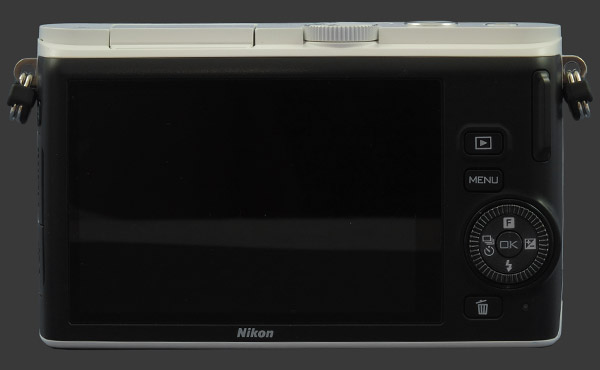
Remaining controls are all found on the back of the Nikon 1 J3 which is dominated by a high-resolution 3" LCD with 920K pixels. It provides 100% coverage. It is unfortunately not Exposure-Priority and, oddly, the LCD does not consistently simulate WB correctly. The view if crisp with a good refresh rate. Visibility is acceptable indoors but washes out under bright light.
To the left of the LCD are three buttons which work just as expected: Playback, Menu and Delete. Delete does nothing in capture mode.
To the right of the LCD us a 4-way controller with central OK button, surrounded by a slim control-dial. Each button is assigned a function:
- Up is for Function which changes depending on the mode-dial position. In Video mode, it selects between PASM and Slow-Motion modes. In Creative mode, it selects between PASM and 7 Scene modes. In Auto mode it gives access to a menu of 4 parameters represented graphically. In Best Moment mode, it selects between Slow-View and Smart Photo Selector. In Motion Snapshot mode, it selects between 4 background music tracks.
- Right is for EC which is then adjusted ±3 EVs in 1/3 increments with the control-dial.
- Down is for Flash mode. Choices, depending on the mode, include On, Redeye, Slow-Sync+Redeye, Slow-Sync and Slow Rear-Sync.
- Left is for Drive mode. There are 8 options: Single-Shot, 5 FPS, 15 FPS, 30 FPS, 60 FPS, 10s, 5s, 2s. Self-timers annoyingly reset after each use.
- OK to start moving the focus-point. Press OK again to get back to normal.
The surrounding control-dial has soft detents and moves very easily. It sets the exposure parameter or the focus distance, depending on the camera mode. In M mode, using EC toggles between Aperture and Shutter-Speed. In MF mode, OK toggles between focus distance and exposure parameters. Note that Nikon 1 lenses do not have focus rings at this time.
For video - which we are grateful to see on any camera - the exact mode is then chosen via the menu. For HD capture, options are 1080i @ 60 FPS, 1080p @ 30 FPS, 720p @ 60 FPS or 720p @ 30 FPS. For Slow-Motion capture, choices are 400 or 1200 FPS.

The bottom of the camera features a metal tripod, in-line with the optical center of the camera, plus a combined battery and memory compartment door. The door hides a standard SDXC and a mid-size battery.
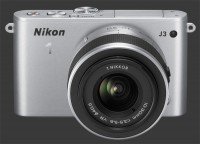 |
Please Support Neocamera
All information on Neocamera is provided free of charge yet running this website is a huge endeavor. Purchases made via affiliate links found throughout the site help keep it running and up-to-date. There is no additional cost to you, so please consider buying via these links to our affilates:
If you found any information on this site valuable and did not purchase via our affiliate links, please considering donating via PayPal:
Any amount will be greatly appreaciated. Thank you for your support!
Nikon J3 Highlights

Sensor-Size: 13 x 9mm

Actual size when viewed at 100 DPI
| 14 Megapixels Mirrorless | ISO 100-6400 |
| Nikon 1 Mount 2.7X FLM | Shutter 1/16000-30s |
| Built-in Dust Reduction | Full manual controls, including Manual Focus |
| 60 FPS Drive, 60 Images | Custom white-balance with 2 axis fine-tuning |
| 1920x1080 @ 30 FPS Video Recording | Spot-Metering |
| 3" LCD 920K Pixels | Lithium-Ion Battery |
| Secure Digital Extended Capacity |
Updates
2025.01.18

Fujifilm GFX 2025 Lens Roundup
Lens Review roundup of Fujifilm GFX Medium-Format lenses. Quality, performance and handling of the GF20-35mm F/4R WR, GF30mm F/3.5 Tilt-Shift and the GF55mm F/1.7.
2024.11.18

Best 2024 Photography Gifts for Every Budget
Great gifts for photographers and photo enthusiasts selected for every budget among the best products of 2024.
2024.08.07

Eye Protection Tips for Professional Photographers
The four main considerations for professional photographers regarding eyewear.
2024.07.14

Fujifilm X100VI Review
Flagship fixed-lens compact digital camera with a 40 MP sensor and Image-Stabilization, a first for the series. Retro design featuring dual control-dials, plus direct ISO, Shutter-Speed and EC dials. Its hybrid viewfinder can switch between EVF and OVF mode.
2024.05.09

Fujifilm GFX100 II Review
Flagship 102 Megapixels Medium-Format Mirrorless Digital Camera with 8-Stop 5-Axis IBIS, 8 FPS Drive, 8K Video and 400 MP Super-Resolution capture in a weatherproof and freezeproof body with dual control-dials and dual memory-card slots.
2024.04.03

Fujifilm X-T5 Review
Newest Fujifilm flagship boasting a 40 MP APS-C sensor, 5-axis IBIS with 7-stop efficiency, 15 FPS continuous drive, 6.2K Video capture, dual control-dials and dual SDXC UHS-II slots in a sturdy weatherproof and freezeproof body.
2023.11.20

Best Digital Cameras of 2023
Find out which are the Best Digital Cameras of 2023. All the new Mirrorless Digital Cameras from entry-level to high-end professional.
2023.07.10

Fujifilm X-H2 Review
40 Megapixels APS-C Hybrid Mirrorless Digital Camera with 7-stop IBIS. Fastest shutter ever and 8K video capture. Large builtin EVF with 0.8X magnification and 5.8 MP, plus an Eye-Start Sensor. Packed with features and large number of controls in a weatherproof and freezeproof body.
2023.05.07

Sony FE 20-70mm F/4G Review
Review of the unique Sony FE 20-70mm F/4G lens. The optical zoom of this lens spans ultra-wide-angle and medium focal-length coverage, making it one of the most versatile Full-Frame lenses on the market.
2023.01.15

Huion Inspiroy Dial 2 Review
Review of the Huion Inspiroy Dial 2 tablet, a medium sized drawing surface with dual dials and customizable buttons. Connects via USB-C or Bluetooth 5.0 with Windows, Linux and Android support.
2022.12.08

How to Pack for a Photo Trip
Find out how to pack for a travel photography trip, carry your gear safely while meeting airline regulations.
2022.11.13

Best Digital Cameras of 2022
The best digital cameras of 2022. A short list of the most outstanding models in their respective categories. Choose one for yourself or as a gift.













